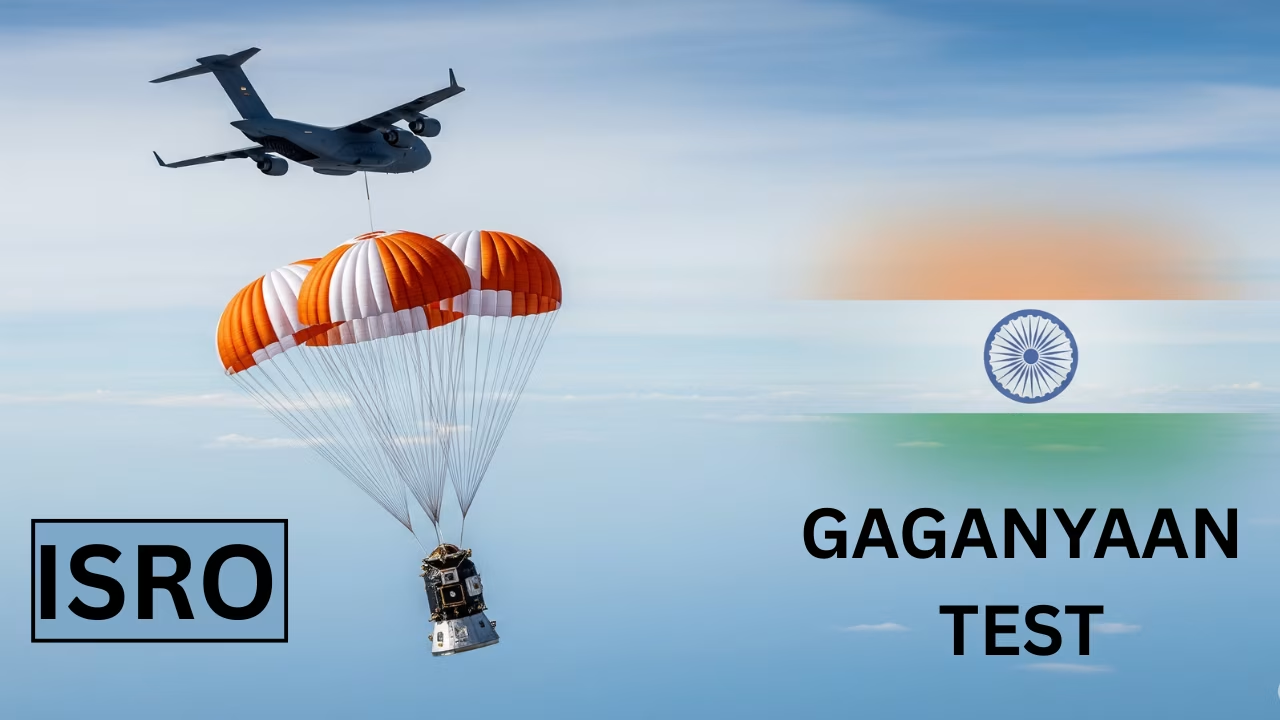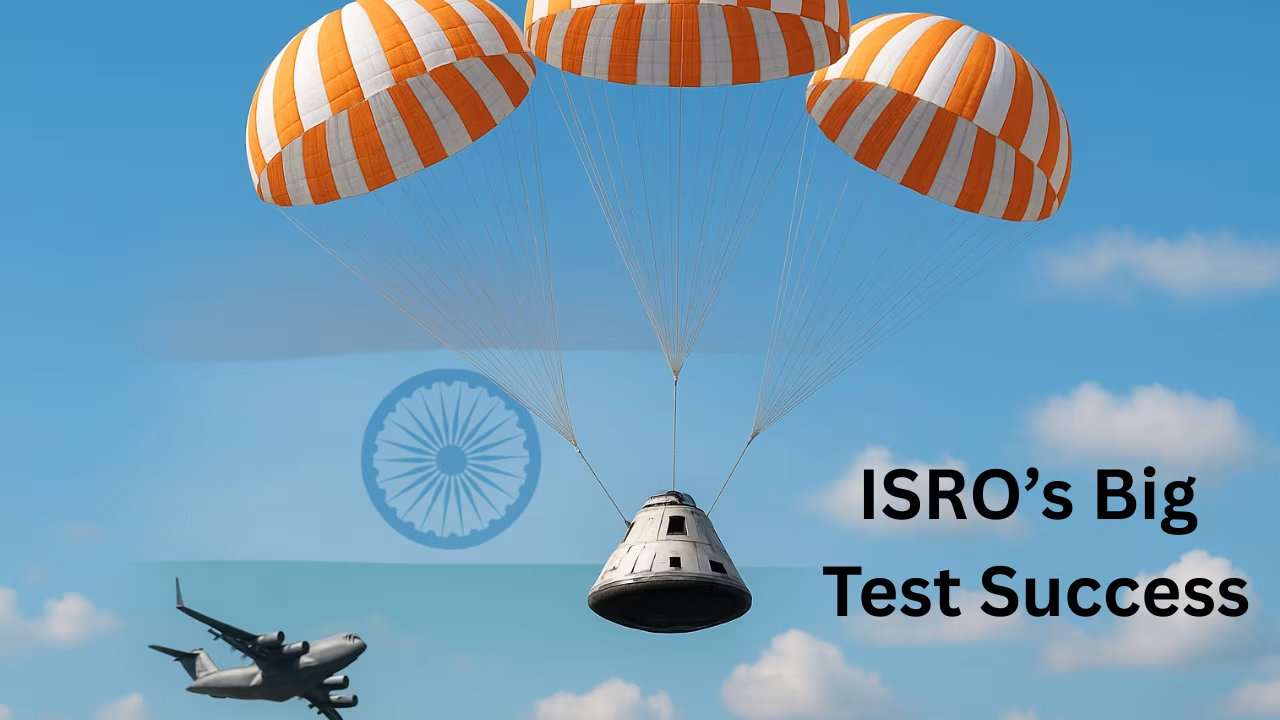
ISRO successfully completes the first integrated air-drop test of the Gaganyaan parachute system, ensuring astronaut safety.
Published on: August 24, 2025 at 20:30
India is inching closer to sending its first astronauts into space, and one of the most critical steps has just been cleared. The Indian Space Research Organisation (ISRO) successfully carried out the first Integrated Air-Drop Test (IADT-01) of the parachute system designed for the Gaganyaan mission. This test is not just about technology—it’s about trust, safety, and the assurance that when India’s astronauts return from space, they will land back on Earth safely.
Conducted with support from the Indian Air Force, DRDO, Navy, and Coast Guard, this test represents a giant stride for India’s human spaceflight program. But why exactly is this milestone so important, and what does it mean for the future of Indian space exploration? Let’s break it down.
What Happened: A Successful Safety Demonstration

The air-drop test was conducted near Sriharikota, where a mock module—designed to replicate the Crew Module (CM)—was released from an Indian Air Force aircraft at high altitude. The goal was to test the parachute-based deceleration system, which is responsible for slowing down the spacecraft during re-entry into Earth’s atmosphere.
Key Highlights of the Test:
-
Parachute Deployment Sequence Validated: The sequence involves drogue parachutes deploying first to stabilize the module, followed by larger main parachutes to decelerate it further.
-
Full End-to-End Simulation: ISRO tested the entire chain of deployment to ensure each step works perfectly in real-world conditions.
-
National Collaboration: The success was the result of collaboration between multiple agencies—DRDO designed the parachutes, the Air Force provided the carrier aircraft, and the Navy and Coast Guard prepared for recovery simulations.
This wasn’t just a lab experiment; it was a real-world, full-scale demonstration that mimicked conditions astronauts will face on their journey home.
Also Read: India Post Halts U.S. Shipments from August 25 — Here’s What Could Stop Your Parcel!
Why It Matters: Safety Above All Else
The Gaganyaan mission isn’t just about sending humans into space—it’s about bringing them back alive and safe. And that’s where parachutes play a life-or-death role.
When the Crew Module re-enters Earth’s atmosphere, it will face extreme conditions:
-
Temperatures exceeding 1,500°C due to atmospheric friction.
-
Speeds of nearly 7.8 km/s (about 28,000 km/h).
-
Intense G-forces as the spacecraft slows down.
After surviving re-entry, the module must land in the ocean with minimal impact. This is where the parachute deceleration system comes into play:
-
The drogue chutes deploy first to stabilize the tumbling capsule.
-
Then, three massive main parachutes open to reduce speed from hundreds of km/h to a safe splashdown velocity.
Without this system, astronauts would face a deadly crash landing. That’s why this test is considered a make-or-break milestone in India’s journey to human spaceflight.
ISRO Chairman S. Somanath and mission directorates have repeatedly emphasized that astronaut safety is non-negotiable. By passing this test, ISRO has sent a strong signal of preparedness to both the Indian public and the global space community.
How India Compares Globally: Learning from NASA & Russia
Human spaceflight is a club with very few members—the USA, Russia, and China. Each of them spent decades perfecting their parachute-based recovery systems before successfully flying humans.
-
NASA’s Apollo & Artemis: The Apollo missions of the 1960s relied on parachutes for ocean splashdowns, and even Artemis capsule recovery tests mirror ISRO’s approach.
-
Russia’s Soyuz Capsules: Russia perfected land-based landings using parachutes and retro-rockets. These have carried cosmonauts safely for decades.
-
China’s Shenzhou Program: China, the most recent entrant, also uses a similar parachute-deceleration system for crewed landings.
ISRO is now standing shoulder-to-shoulder with these agencies, learning from their successes while innovating with indigenous technology.
The Road Ahead: What Comes After This Test

The air-drop test is just one part of the 7,700+ mission-critical tests that ISRO must complete before Gaganyaan’s crewed flight. About 80% of these are already done, but several milestones remain:
Upcoming Steps in the Gaganyaan Program:
-
More Parachute Trials: ISRO will conduct multiple air-drop tests under different conditions—wind speeds, altitudes, and failure scenarios—to ensure reliability.
-
Uncrewed Flight in December 2025: The next big event is the launch of an uncrewed mission featuring Vyommitra, a humanoid robot designed to mimic astronaut behavior inside the capsule.
-
Pad Abort & Escape System Trials: Safety systems that can jettison the crew away from the rocket in case of failure will undergo additional validation.
-
Crewed Flight by 2027: If all goes well, India’s first astronauts will orbit Earth for up to three days, making India the fourth country to launch humans into space.
Beyond Gaganyaan, ISRO has ambitious plans—a space station by 2035 and crewed lunar missions by 2040. The parachute test is, therefore, a foundation stone for an entire future of Indian space exploration.
The Human Side: Why This Mission Inspires India
Beyond the technical details, the Gaganyaan mission is deeply emotional. For decades, India has watched American astronauts, Russian cosmonauts, and Chinese taikonauts fly into space. Now, with every successful test, the dream of seeing Indian astronauts—Vyomnauts—become reality.
This success also resonates with the younger generation, inspiring students to pursue careers in science and engineering. ISRO’s achievements highlight that India is not just catching up with global leaders but is also creating its own place in the new space economy.
Also Read: PM Modi Speaks with Putin on Phone: Discusses Alaska Summit and India’s Call for Peace in Ukraine
A Giant Leap Toward Human Spaceflight
ISRO’s first integrated air-drop test for the Gaganyaan parachute system is more than just a test—it’s a symbol of trust, safety, and national pride. By successfully demonstrating the parachute sequence, India has ensured that its astronauts will have a safe path back to Earth.
The journey to space is never easy, but milestones like these prove that India is ready for the challenge. As the December 2025 uncrewed flight approaches, the dream of India’s first human spaceflight inches closer to becoming a historic reality.





